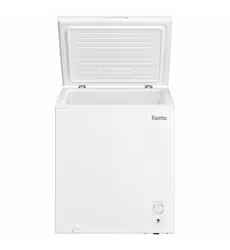Loading ...
Loading ...
Loading ...

esatto.house
13
Defrosting
The freezer can only be manually defrosted.
• Unplug the freezer and open the freezer door, remove foods and shelving basket before defrosting
• Open the outow hole and drainage hole (place water container at the drainage hole}; the indoor frost will
naturally melt, wipe the defrost water with a dry, soft cloth. When the frost softens, an ice scraper might
be used to the accelerate defrosting process.
• Please remove the food and put in a cool place when defrosting before removing accessories.
WARNING Other mechanical devices or other means shall not be used to accelerate except those
recommended by the manufacturer. Do not damage the refrigerant circuit.
Cleaning
WARNING Before cleaning the appliance, make sure it is switched o and disconnected from the power
supply. Failure to do so can result in electric shock or injury.
• Dusts behind the refrigerator and on the ground shall be timely cleaned to improve the cooling eect and
energy saving.
• Check the door gasket regularly to make sure there are no debris. Clean the door gasket with a soft cloth
dampened with soapy water or diluted detergent.
• The interior of the refrigerator should be cleaned regularly to avoid odor.
• Please turn o the power before cleaning, remove all food, basket, container, etc.
• Wash the inside surfaces and the interior accessories with a damp, warm cloth moistened in a water and
baking soda solution. The solution should be about 2 tablespoons of baking soda to 1 litre of water. Rinse
and wipe dry with a soft cloth.
• Clean the outside of the unit with a damp, well wrung out cloth, keeping the area of the controls dry. Keep
the lid gasket (seal) clean.
• For areas that are dicult to clean in the freezer (such as gaps or corners), it is recommended to wipe
them regularly with a soft rag, soft brush, etc. and when necessary, combined with some auxiliary tools
(such as thin sticks) to ensure no contaminants or bacterials accumulation in these areas.
• Never use boiling water to accelerate defrosting as it may damage the plastic components.
• Do not use hard brushes, clean steel balls, wire brushes, abrasives (such as toothpastes), organic solvents
(such as alcohol, acetone, banana oil, etc.), boiling water, acid or alkaline items, which may damage the
freezer surface and interior. Boiling water and organic solvents such as benzene may deform or damage
plastic parts.
• After cleaning/defrosting, push the drain plug in.
• After everything is dry, place appliance back into service.
• Allow approximately 1–2 hours for the cabinet to cool down again (depending on the length of time the
appliance was disconnected from the power).
WARNING
Never clean the unit with an abrasive, acid, oil or solvent based cleaning agent. Never use ammable uids
or sprays for cleaning as the fumes from these substances can create a re hazard or explosion.
Out of Operation
• Power failure: In case of power failure, even if it is in summer, foods inside the appliance can be kept for
several hours; during the power failure, the times of door opening shall be reduced, and no more fresh
food shall be put into the appliance.
• Long-time nonuse: The appliance shall be unplugged and then cleaned; then the doors are left open to
prevent odor.
• Moving: Before the refrigerator is moved, take all objects inside out, x the glass partitions, vegetable
holder, freezing chamber drawers and etc. with tape, and tighten the leveling feet; close the doors and x
them with tape. During moving, the appliance shall not be laid upside down or horizontally, or be vibrated;
the inclination during movement shall be no more than 45°.
Mintennce nd Clening
Loading ...
Loading ...
Loading ...
